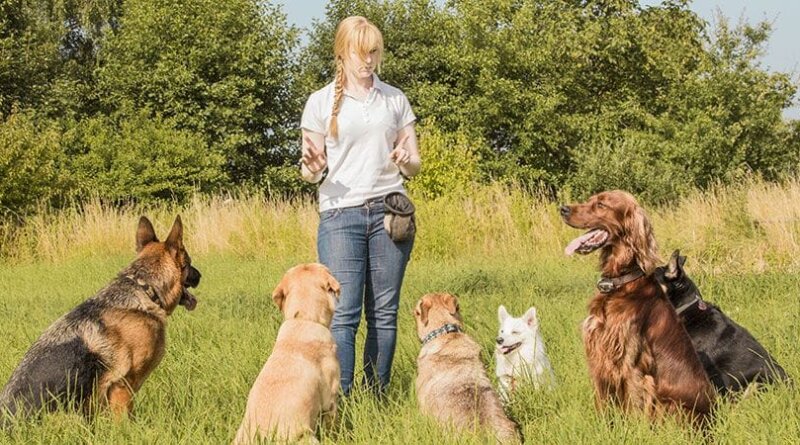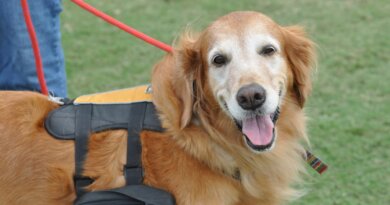5 Essential Dog Commands | Learn Basic Dog Commands
Are you looking for the best commands to teach your dog? Although having a trained dog isn’t the same as having a balanced dog, teaching your dog basic dog training commands can be helpful when tackling behavior problems despite whether they are existing ones or those that may develop in the future.
So where exactly do you start with teaching your dog commands? While taking a class may be beneficial for you and your pup, there are many dog training commands you can teach your dog right at home. Below, we’ve listed the best list of dog commands you and your pup are guaranteed to enjoy.
Dog Training Commands Your Pup Needs to Learn
If you want your pup to be disciplined and obedient, there are some essential dog commands you should teach early on. Teaching your dog essential commands not only ensures they can follow your directions, but also can help prevent or address unwanted behaviors later on. Learning new tricks is also a great way for your dog to stay challenged and mentally active!
Sit
Teaching your dog “sit,” one of the most basic dog commands, is a great one to start with. A dog who knows the “Sit” command will be much calmer and easier to control than dogs who aren’t taught this simple command. Additionally, the “Sit” command prepares your dog for more advanced commands such as “Stay” and “Come.”

Teach Your Dog to Sit
Early on in your pup’s life, you’ll want to begin training sessions so that they can learn basic commands. Starting by teaching your dog “sit” is easy enough and sets your pup up for success with future dog training.
Here’s how to do it:
- Hold a treat close to your dog’s nose.
- Move your hand up, allowing his head to follow the treat and causing his bottom to lower.
- Once he’s in a sitting position, say “Sit,” give him the treat, and share affection.
Repeat this sequence a few times every day until your dog has it mastered. Then, ask your dog to sit before mealtime, when leaving for walks, and during other situations when you’d like him calm and seated.

Come
Another important command for your dog to learn is the word “come.” This command is extremely helpful for those times you lose grip on the leash or accidentally leave the front door open. Once again, this command is easy to teach and will help keep your dog out of trouble.
Teach Your Dog to Come When You Call Him
Your dog’s ability and willingness to follow your instructions is about more than just obedience; an important command like “come” can save your dog’s life if he happens to get loose. Here’s how to teach your dog this essential command:
- Put a leash and collar on your dog.
- Get down to his level and say, “Come,” while gently pulling on the leash.
- When he gets to you, reward him with affection and a treat.
Once he’s mastered it with the leash, remove it, and continue to practice the command in a safe, enclosed area.
Down
This next command is one of the more difficult dog training commands to teach. The reason it may be hard for your dog to master this command is that it requires him to be in a submissive posture. You can help out your dog by keeping training positive and relaxed, especially if your dog is fearful or anxious. Also keep in mind to always praise your dog once he successfully follows the command.

Teach Your Dog to Lie Down
Excitable pups are cute, but as they get bigger and stronger, their excitement can be dangerous. Whether they’re prone to jumping up on guests or they’re a little over-eager when interacting with other pets, teaching your dog to lay down on command can be helpful.
- Find a particularly good smelling treat, and hold it in your closed fist.
- Hold your hand up to your dog’s nose. When he sniffs it, move your hand to the floor, so he follows.
- Then, slide your hand along the ground in front of him to encourage his body to follow his head.
- Once he’s in the down position, say “Down,” give him the treat, and share affection.
Repeat this training every day. If your dog tries to sit up or lunge toward your hand, say “No” and take your hand away. Don’t push him into a down position, and encourage every step your dog takes toward the right position. After all, he’s working hard to figure it out!

Stay
Similar to the “Sit” command, the “Stay” cue will help make your dog easier to control. This command can be helpful in a number of situations such as those times you want your dog out of the way as you tend to household chores or when you don’t want your pup overwhelming guests.
Before attempting to teach your dog this command, make sure your dog is an expert at the “Sit” cue. If he hasn’t quite mastered the “Sit” command, take the time to practice it with him before moving on to the “Stay” cue.
Teach Your Dog to Stay Put
Young puppies don’t like to sit still, but it’s really important to teach them the “stay” or “wait” command. This command will help your pup learn to wait for you to tell them they can move, which can be especially helpful in new or dangerous situations.
- First, tell your dog to “sit.” You can also use “down” here.
- Then, open the palm of your hand in front of you, and say, “Stay.”
- Take a few steps back. Reward him with a treat and affection if he stays.
- Gradually increase the number of steps you take before giving the treat.
- Always reward your pup for staying put — even if it’s just for a few seconds.
It’s also important to incorporate a release word (such as “okay”) to tell your dog when he is good to approach. This is an exercise in self-control for your dog, so don’t be discouraged if it takes a while to master, particularly for puppies and high-energy dogs. After all, most dogs prefer to be on the move rather than just sitting and waiting.
Leave it
This last command can help keep your dog safe when his curiosity gets the better of him such as those times when he smells something intriguing but possibly dangerous on the ground. The goal is to teach your pup that he gets something even better for ignoring the other item.

Teach Your Dog to Leave Something Alone
When it comes to the most important dog commands, “leave it” can be crucial. Whether your pup is sniffing around your food too much or he’s interested in snacking on something that could harm him, teaching him to leave something alone, even if it smells good, is something you should prioritize.
- Place a treat in both hands.
- Show him one enclosed fist with the treat inside and say “Leave it.”
- Ignore him when he licks, sniffs, mouths, paws and barks to get the treat.
- Once he stops trying, give him the treat from the other hand.
- Repeat until your dog moves away from that first fist when you say “Leave it.”
- Next, give your dog the treat only when he looks up at you as he moves away from the first fist.
Once your dog consistently moves away from the first treat and gives you eye contact when you say the command, you’re ready to take it up a notch. For this next training method, use two different treats: one that’s good but not super-appealing and one that’s particularly good-smelling and tasty for your pup.
- Say “Leave it,” place the less-attractive treat on the floor and cover it with your hand.
- Wait until your dog ignores that treat and looks at you. Then, remove that treat from the floor, give him the better treat, and share affection immediately.
- Once he’s got it, place the less-tasty treat on the floor but don’t completely cover it with your hand. Instead, hold your hand a little bit above the treat. Over time, gradually move your hand farther and farther away until your hand is about 6 inches above.
- Now, he’s ready to practice with you standing up! Follow the same steps, but if he tries to snatch the less-tasty treat, cover it with your foot.
Obedience Training for Dogs: Basic Dog Commands to Improve Discipline
Don’t rush the process of teaching your pup any one of these dog training commands. Remember, you’re asking a lot of your dog. If you take it up a notch and he’s really struggling, go back to the previous stage.
This list of dog commands can help protect your dog from dangerous situations as well as improve your communication with him. Taking the time to teach your pup these common dog commands is well worth the investment of your time and effort. While teaching your dog to sit and stay may not be a cute trick, these dog commands are incredibly important to ensuring your pup listens to you. A trained pup will be well-behaved, docile, and safe. It’s in your best interest (and his!) to start training sessions early on.
Remember, the training process takes time, so start a dog-obedience training session only if you’re in the right mindset to practice calm-assertive energy and patience.
Considering health insurance for your dog but budget is a concern? Our partners at ConsumersAdvocate.org can help.




